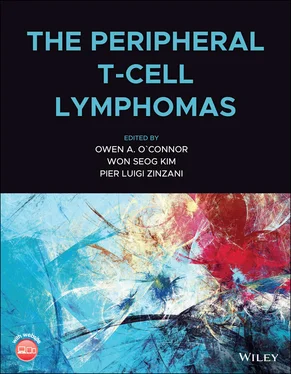1 ...8 9 10 12 13 14 ...40 Epigenetic alterations are not sufficient per se to drive tumor transformation. Indeed, most patients with isolated TET2 or DNMT3A mutations in hematopoietic progenitors develop clonal hematopoiesis of indeterminate potential [29, 30], and will not further develop a clinical hematologic malignancy [29, 30]. Furthermore, transgenic mice models that inactivate TET2 or DNMT3A do not develop spontaneous lymphoid malignancies or they develop with a very low penetrance [31, 32]. Both observations suggest that disruption of an epigenetic regulator is not sufficient and requires “second‐hit” events, especially affecting the cell signaling to drive T‐cell lymphomagenesis.
In normal T cells, T‐cell receptor (TCR) engagement by a specific peptide presented by the major complex of histocompatibility, when associated with activation signals from co‐stimulatory pathways, activates the transmission of positive signals using several critical signaling pathways. These will result in proliferation, activation, and metabolism adaptation. The main co‐stimulatory receptors are CD28 and ICOS, whereas PD1 and CTLA4 are responsible for negative regulation. Activation of TCR signaling induces activation of calcium mobilization, RAS activation, resulting in mitogen‐activated protein kinase, nuclear factor kappa B (NF‐κB) and activator protein 1 (AP‐1) activation, and cytoskeletal reorganization [33].
Converging data support an important role of TCR signaling in T‐cell lymphomagenesis. First, a specific translocation [t(5,9)(q33;q22)] has been reported in some PTCLs, which leads to the generation of an abnormal ITK‐SYK fusion protein [34] and to the development of a PTCL with constitutively activated TCR signaling in a transgenic mice [35]. Interestingly, independently of SYK/ITK fusion, SYK overexpression appears common to many PTCLs [36]. Second, 50–70% of Tfh‐derived PTCLs harbor a mutation in RHOA encoding for the p.G17V substitution [4, 14, 37]. Although the expression of the RHOA G17Vvariant in T cells was associated with disruption of the classical functions of RHOA, it induced increased cell proliferation and invasiveness in in vitro models [14, 37]. These effects could be explained by a change in the interactome of RHOAG17V mutant, which binds VAV1, resulting in VAV1 phosphorylation and NFAT signaling activation, indicating that RHOA mutation could be a major player in T‐cell signaling activation [38]. The link between RHOAG17V mutation and VAV1 activation is reinforced by the observation that VAV1 activating mutations or translocations are mutually exclusive to RHOAG17V mutations [38]. Interestingly, mouse models combining TET2 loss with expression of the RHOA G17Vmutant in T cells, especially when combined with TCR stimulation by immunization, develop AITL‐like disease, confirming the concept that combination of TET2 and RHOA mutations can drive Tfh PTCL oncogenesis [39, 40]. In addition, sparse mutations among other genes involved in proximal or distal TCR signaling, such as CD28, PLCG1 , and PI3K elements, have been detected in 50% of patients with PTCL, resulting in increased cell activation and proliferation [41]. Furthermore, in addition to CD28 activating mutations, CD28‐ICOS or CD28‐CTLA4 fusions, resulting in CD28 signaling activation, are present in around 5% of PTCL, notably in Tfh‐derived PTCL [5].
Alterations in genes involved in TCR or co‐stimulation pathways are also found in other PTCL entities, especially cutaneous T‐cell lymphomas (CTCL), where PLCG1 mutations are frequent [42]. DUSP22 , a gene found to be rearranged in around 30% of systemic and cutaneous ALK‐negative ALCL, is a tumor suppressor gene encoding a dual‐specificity phosphatase, which inhibits TCR signaling and growth and promotes apoptosis in experimental models [43]. Interestingly, DUSP22 ‐rearranged ALCLs lack activation of signal transducers and activators of transcription 3 (STAT3), in contrast to other ALCLs, but associates with recurrent mutations in the musculin ( MSC ) gene, which in turn drive expression of the CD30–IRF4–MYC axis and cell cycle progression [44]. PTEN anomalies, resulting in PI3K signaling activation are also described in a significant proportion of cases [45]. In ATLL, integrative genomic studies also demonstrated the presence of mutations altering the TCR and NF‐κB pathway, such as mutations in PLCG1 , PRKCB , CARD11, VAV1, IRF4, FYN, CCR4 , and CCR7 [46].
The inactivation of inhibitory signals can also result in T‐cell activation. Recent progress in immunotherapy revealed that PD1 is a critical element for T‐cell inhibition. A mouse model revealed that PD1 inactivation, mostly by deletion of Pdcd1 , the gene encoding for PD1, allowed for tumor transformation in T cells harboring the ITK‐SYK translocation [47]. PDCD1 deletions are found in several PTCLs, but especially CTCL [47]. This potential tumor suppressor role of PD1 in PTCL raises some questions regarding the use of PD1–PDL1 checkpoint inhibitors in PTCL, which are currently under investigation.
The Janus‐associated kinase (JAK)–STAT pathway is also pivotal for T‐cell regulation, as it is critical for the transmission of the signal from cell membrane receptors to the nucleus. Engagement of a type I or type II cytokine receptor by a cytokine or growth factor induces JAK transphosphorylation and subsequent recruitment, phosphorylation and dimerization of STAT proteins that will enter to the nucleus to activate gene expression. There are four members of the JAK family (JAK1, JAK2, JAK3 and TYK2) and seven STAT proteins (STAT1, STAT2, STAT3, STAT4, STAT5a, STAT5b, and STAT6). JAK–STAT signaling is involved in T‐cell activation and proliferation. In addition, the functional differentiation of CD4+ cells relies on different JAK–STAT family members (for example, STAT1/STAT4 seems to be involved in Th1 differentiation, STAT6 in Th2, STAT3 in Th17 and STAT5 in Treg polarization) [48]. Activation of the JAK–STAT pathway is common to several PTCLs, and is particularly frequent in cytotoxic lymphomas. In ALK‐positive ALCLs ALK fusion proteins lead to activation of the JAK–STAT3 signaling [49]. Alternative mechanisms of JAK–STAT3 activation are observed in the majority of ALK‐negative ALCLs, including mutations in JAK1 and/or STAT3 in up to 20% ALK‐negative ALCL and fusions involving ROS1, TYK2, or FRK . In these lymphomas, co‐occurring mutations in two genes of the JAK/STAT pathway for example in STAT3 and JAK1 could act synergistically to amplify JAK/STAT signaling and sustain cell transformation [28, 50]. STAT3 mutations are detected in one third of large granular lymphocyte leukemia [51]; JAK3, STAT3 , and STAT5B mutations in a proportion of ENKTL, nasal type [26, 52]; JAK3 and above all STAT5B mutations in up to 60% of MEITL [23], whereas STAT5B , or more rarely STAT3 are mutated in 30 and 10% of HSTL, respectively [24]. These mutations are associated with increased JAK–STAT signaling, as suggested by the increased nuclear expression of pSTAT3 or pSTAT5 in mutated cases. In addition, inactivating mutations in negative regulators ( SOCS1, SOCS3, PTPN1 , and others) of the pathway may also contribute to increasing JAK–STAT signaling [28].
TP53 , the gene that encodes for p53, the guardian of the genome, is probably the most studied tumor suppressor gene. P53 regulates multiple cellular functions, such as DNA repair, cell‐cycle arrest, apoptosis, senescence, and metabolism. TP53 mutations or deletions are found in around 50% of cancers, and commonly correlate with chemoresistance and poor prognosis. Inactivating TP53 mutations are reported with a variable frequency, being uncommon in Tfh‐derived PTCL, and more frequent in PTCL‐NOS. In particular, a PTCL‐NOS subset characterized by genomic instability and a poorer prognosis, partially overlapping with the GATA3–3‐positive molecular subgroup [6] is enriched in TP53 anomalies [6, 53]. In ATLL, TP53 mutations are found in less than 20% of the patients, where they associate with chemoresistance and short survival [46]. They are also common in extranodal PTCL, such as ENKTL [25] and enteropathy‐associated T‐cell lymphoma (EATL) [54].
Читать дальше












